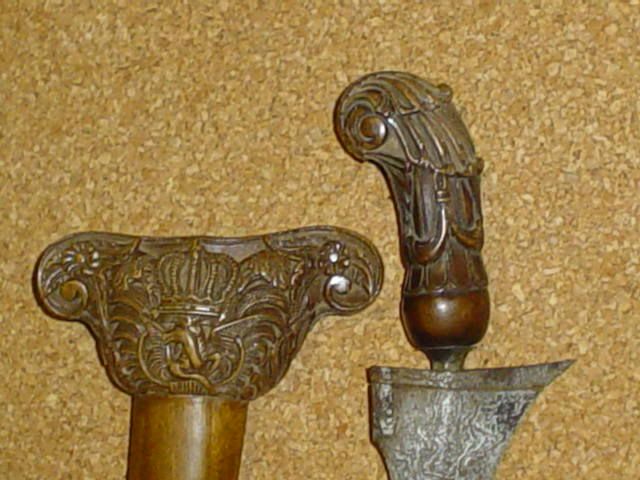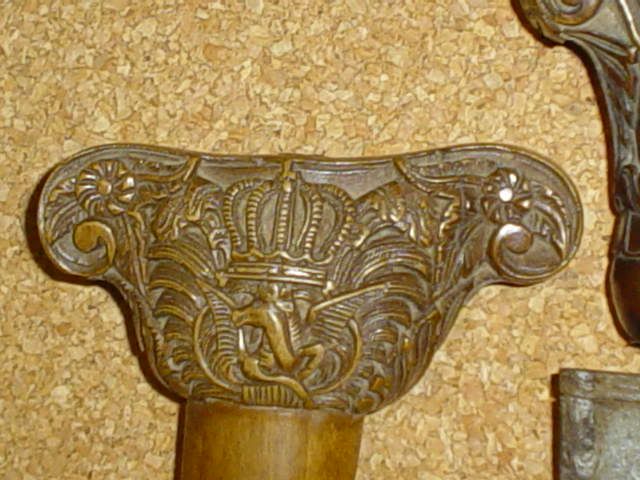
 |
|
|
|
|
#1 |
|
Member
Join Date: Dec 2004
Location: Sweden
Posts: 1,637
|
The Gayaman sheath, Solo version, is also seen sometimes.
Michael |
|
|

|
|
|
#2 |
|
Vikingsword Staff
Join Date: Nov 2004
Posts: 6,378
|
This combination seems to have been together for a long time .
The pesi is wrapped with human hair. I've never had this one apart; I'm kind of superstisius about this one. 
|
|
|

|
|
|
#3 |
|
Member
Join Date: Dec 2004
Location: Sint-Amandsberg (near Ghent, Belgium)
Posts: 830
|
Here is a Madura keris in my collection
  
|
|
|

|
|
|
#4 |
|
Keris forum moderator
Join Date: Aug 2006
Location: Nova Scotia
Posts: 7,261
|
Here are a few more examples. Please excuse the image quality, as i shot these very quickly on my porch this afternoon
 : :
|
|
|

|
|
|
#5 |
|
Keris forum moderator
Join Date: Aug 2006
Location: Nova Scotia
Posts: 7,261
|
Here are three patrems from Madura in three basic sheath forms:
|
|
|

|
|
|
#6 | |
|
Member
Join Date: Jan 2005
Location: Singapore
Posts: 1,248
|
Quote:
 The wood-grains are fantastic. Thanks for sharing. Now back to the topic... The wood-grains are fantastic. Thanks for sharing. Now back to the topic... 
|
|
|
|

|
|
|
#7 |
|
Keris forum moderator
Join Date: Aug 2006
Location: Nova Scotia
Posts: 7,261
|
Thanks Shahrial. You might have a tougher time getting me to show the blades.
  That first one is a beauty indeed. This is one of my few all modern keris (dress and blade), with a late 20thC blade. I am very pleased this level of craftsmanship still exists. 
|
|
|

|
|
|
#8 |
|
Member
Join Date: May 2006
Posts: 7,134
|
I possibly may have examples of gabilan and brahmana rsi around somewhere, but I can`t put my hand on them, and right now I do not have time to look. The highly carved example with the horse handle, that David posted, would be a gabilan. Brahmana rsi is more scarce, and is also highly carved, but is a fatter style.The examples I saw in the museum gave every appearance of being quite old.
With motifs on handles, a crown and tumpal ( a triangular pattern) is normally associated with Pamekesan, the winged horse and a dragon with Suminep. What I meant by "---win in court---" was that I like to be pretty positive about something if I state that something is so. I may still be wrong, but if I say something is so, I want to be able to mount a case based on evidence and/or logical argument, that will prove my point or position. I dislike intensely, hypothesis presented as fact. Yes, I agree, it does help if everybody can use the same terminology in a discussion. One of the great advantages of Harsrinuksmo`s ensiklopedi is that it provides a very adequate vocabulary to allow keris discussion. In describing or discussing keris, I will often not use the terminology or names that I have learnt over the years, and will instead opt to use the terms that everybody understands.I think everybody generally understands Surakarta terms for wrongkos, so I usually use these terms, rather than try to use the correct regional term for type of wrongko. With the handle of a keris , I usually use the word "handle", simply because there are several words in general use in Jawa---ukiran, jejeran, gagang---and the name for a handle varies from place to place, so I use handle as the word everybody understands. Even in Bali, dealers who sell keris handles now refer to them as "endel". The stories might have to wait. |
|
|

|
|
|
#9 |
|
Member
Join Date: Dec 2004
Location: Boca Raton, Florida, USA
Posts: 108
|
Alan, I knew that there would properly be a reaction with the photos of the mamas sandang walikat, and generally speaking it is perhaps more prevelent to say that the mamas wrongko is associated with East Jawa more so than Madura, but there is a fine line (and a short distance) on this one as I have seen many mamas attributed to Madura.
In my humble opinion it is sort of a "cross dresser" much like the wrongko's with Kala Langgam which as a Madura fashion can be seen in Bali, East Jawa, Central Jawa and even as an ornament on a presently listed Bugis Keris. A few more: |
|
|

|
|
|
#10 |
|
Member
Join Date: May 2006
Posts: 7,134
|
Yes, I have also often wondered at the variety in Madura wrongkos. There`s a lot of variety in the handles too.
Regarding the photos that have already been posted:- VVV--- I don't think this is a Solo style wrongko, it appears to me to be East Jawa; Madura is of course a part of East Jawa. The handle looks like an old North Coast one, not Madura. Rick---why do you think this is Madura dress? The wrongko is Jogja, although the handle is Madura. Here are few Madura wrongkos from my own collection. I`ve left handles and blades, and mendak out of it for the time being, to allow us to focus on just one element of dress at a time. |
|
|

|
|
|
#11 |
|
Member
Join Date: May 2006
Posts: 7,134
|
And a couple more.
|
|
|

|
|
|
#12 |
|
Vikingsword Staff
Join Date: Nov 2004
Posts: 6,378
|
[QUOTE=A. G. Maisey
Rick---why do you think this is Madura dress? The wrongko is Jogja, although the handle is Madura. Because the shape is so similar to the one you present as Madura and the one David also presents . I perceive a similar certain lack of 'belly' on the left hand end . I guess I need a finer eye to discern Jogya gayaman wrongkos from Maduran . |
|
|

|
|
|
#13 |
|
Member
Join Date: Jan 2005
Location: Singapore
Posts: 1,248
|
Are there names to identify the various types of sheath form?
Afaik, from the pictures... Ladrang Madura, Gayaman Madura and Sandang Walikat Madura in general. David, your 1st piece, the sheath form is interesting and a beauty (the bird hilt too.) Your horn Sandang Walikat sheath is exquisite. Alan, what are these type called? This one, the wings reminds me of the piece from Nagasasra's "Unusual Keris Dress from where?" thread. http://www.vikingsword.com/vb/attach...id=13594&stc=1 This one, the central panel is typical of Maduran carvings, common especially on Donoriko hilt form. But its unique on this sheath form. http://www.vikingsword.com/vb/attach...id=13613&stc=1 This one, upper portion of the wrangka, looks almost a Malay form, except for the carvings and the curves at the lower part of the cross-piece. Interesting thread... 
|
|
|

|
|
|
#14 |
|
Member
Join Date: May 2006
Posts: 7,134
|
I'm sorry, I cannot give names on Madura keris with any authority, and it is not my habit to say something unless I can back it up.
I have visited Madura a few times, and have spent a bit of time in the area of Suminep, but even when I was there, I was getting given different names for the same thing , by different people. To be absolutely honest about this naming of things, it is something that has very little interest for me. It used to have, but as time has gone by I have found that one person will swear that something is called such and such, and then an equally qualified person will come along and call it something else, or I`ll go ten miles down the road and find it has a different name, or I`ll get a firm fix on the name of something, and then ask the same highly respected source ten years later what the same thing is called, and get a different name. I call this whole thing :- "the name game", and I feel that the only way in which it should be played is by giving the name, along with the source, the geographic location it was obtained, and the date. With Madura dress, some of the motifs can be identified with either Suminep or Pamekesan. I have seen two styles of highly carved wrongkos in the Suminep Kraton museum that were identified as "gabilan", and "brahmana rsi". I have heard stories about the origin of some motifs and some wrongko styles. But I cannot give names for the wrongko styles, nor the handle styles, that I could present a case in court for, and win. |
|
|

|
 |
|
|